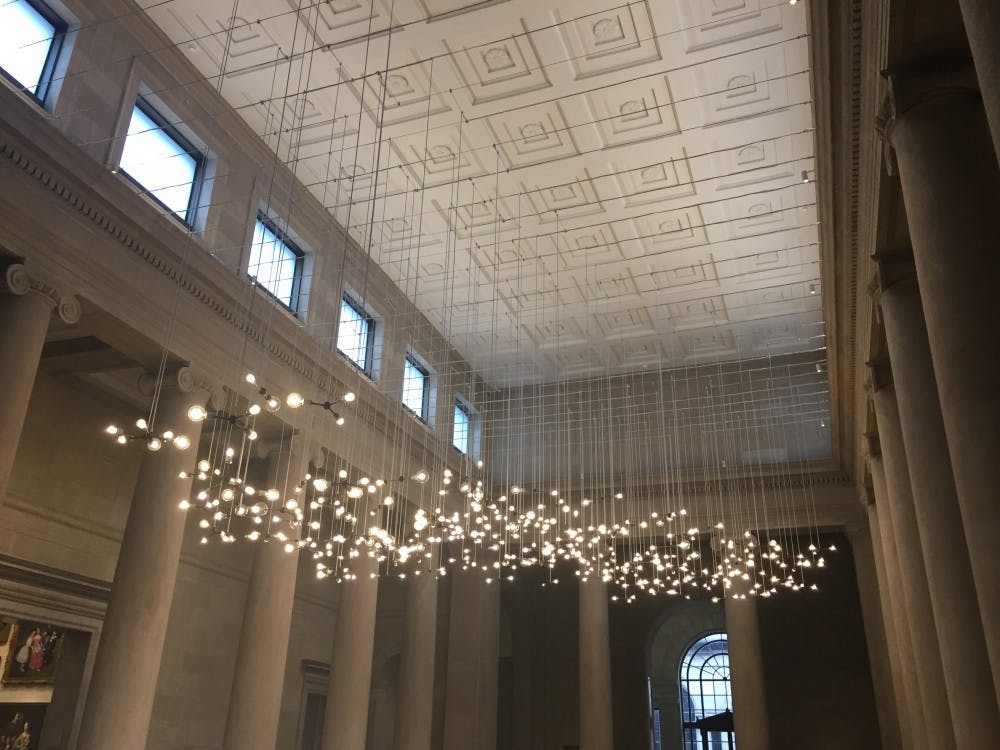Spencer Finch’s Moon Dust (Apollo 17) opened at the Baltimore Museum of Art (BMA) on Feb. 21, 2018. The installation was originally presented at the 2009 Venice Biennale and creates a beautiful intersection between art and science.
As evidenced by its title, the work is a nod to NASA’s final Apollo mission in 1972 and is, in fact, a scientifically precise representation of the chemical composition of moon dust as it was gathered during the Apollo 17 mission, as well as an abstract hanging sculpture.
The sculpture comprises “150 individual chandeliers with 417 lights,” according to the BMA website, which translates to 150 vertical wires with 417 LED bulbs attached to the fixtures. The “chandeliers” are hung individually from the ceiling and form one large, cloud-like structure.
Finch translated the diagrams of the chemical formulas of the molecules found in the moon dust, replicating the compositions of the elements through different sizes of light bulbs.
Each size represents one element bonded in the molecules, and the bigger the light bulb, the heavier the corresponding element. Small bulbs represent helium and bigger bulbs represent oxygen, for example.
In essence, Finch used light bulbs of different diameters and customary fixtures with different arm lengths to create a three-dimensional scale model of the moon’s atomic makeup.
To anyone that knows me, I am basically the antithesis of a STEM person, but there is something magical about the intersection between art and science.
As I was wandering around Fox Court, which is where the exhibition is (ask someone who works there to tell you how to find it; it’s very confusing), I heard a mother say something that exemplified this to me: “You know what inspired this art? Science. Isn’t that cool?”
What I’m trying to say is that even for the die-hard STEM majors out there who have absolutely zero interest in going to an art gallery, maybe this would be a good option for you. At the very least, you’ll get a good Instagram picture out of it because this installation was basically made to be photographed.
I really don’t think that you can capture the feeling of standing under an array of 417 light bulbs, perfectly placed and descending over your head. I think that there’s something intrinsically magical and romantic about the piece, inherent in the fact that it’s depicting moon dust and the oxymoronic nature of using light bulbs to depict the moon.
In the book Spencer Finch: The Brain is Wider Than the Sky, author Susan Cross writes, “At the heart of Finch’s practice is this romantic impulse to see what others have seen, and to share that impression — to accurately convey it — to a multitude.”
I think that Finch achieves that in this piece. He has taken something that’s typically viewed under the lens of a microscope and literally put it over our heads.
Interestingly the piece wasn’t originally designed for this location, and — while it definitely works and fits in the space and beautifully reflects off the glass door at one end of the room — there is definitely a jarring juxtaposition between the classical columns and European art in the adjoining rooms.
I’m not sure if this adds to the feeling of modernity and otherworldliness that accompanies the piece or whether there is just something a bit forced about putting it into an environment in which it doesn’t really fit.
Having looked at pictures of the installation at the Venice Biennale (which essentially looks like a warehouse), it definitely fits better in the location for which it was designed, which is unsurprising. There is something intriguing, however, about how modern art fits into more “traditional” settings for art.
While I wouldn’t say that you necessarily need to rush out and see this installation (it’s running until 2024, so you have plenty of time) it is definitely worth seeing. The BMA is close, and it would be a shame not to see this while it’s here.
While you’re there, you should definitely have a look at Tomás Saraceno’s Entangled Orbits — the installation that I can guarantee you have seen at least once on Instagram/Snapchat, if you haven’t seen it in person.
Take a break out of your busy schedule, walk over to the BMA and just stop and think for a while — even if you end up thinking about how insignificant we really are in the grand scheme of things. Maybe it will make that one midterm you didn’t do well on seem less important, and I can confidently say that that would be a good thing for all of us.





